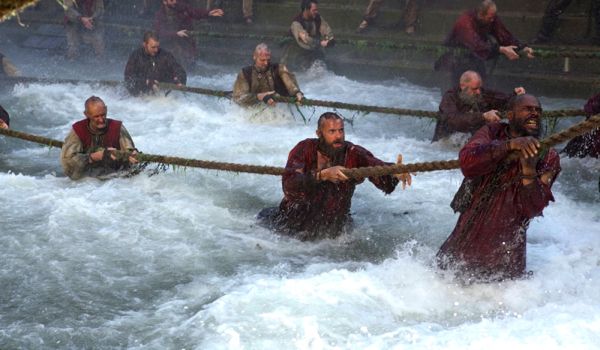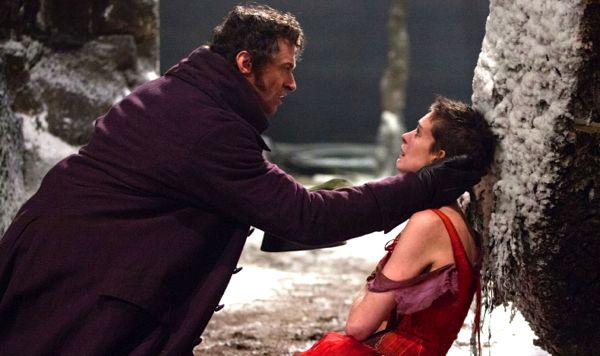By Ray Bennett
Fans of the musical “Les Miserables” guarantee that it will make you cry, and they are right. Like the stage show, the film is a near three-hour wallow in a swamp of misery with an endless litany of choruses on a variation of “Woe is me”. When I realized they were never going to shut up, that’s when I wept.
There is a big cast topped by Hugh Jackman, Anne Hathaway and Russell Crowe but bad music combined with banal words exposes every flaw in performers and only one or two come out of it well.
It’s notable that over 25 years the stage show failed to produce a hit song – usually a requirement in musicals – until one of Simon Cowell’s acolytes rendered one almost hummable. The perpetrators of the original penned something new for the film, titled “Suddenly”, but it’s indistinguishable from the rest.
Director Tom Hooper saves a great deal of expense on sets and locations by placing much of the action in the cast’s tonsils. The stage show seems designed to blast the audience through the back wall of the theatre but in the film Hooper puts everyone not so much in the front row as on the stage to be screamed at personally.
Set in the 19th century in a France beset by cruel laws and even worse toiletry, the story tells of Jean Valjean, who was sentenced to many years of hard labour after he stole a sandwich. The film begins with a sequence with some of the worst CGI in memory in which Valjean labours with several hundred other men to haul a sailing vessel by rope into a vast dock while they warble a droning syncopated number about looking down. High above them struts their overseer, Javert, who despite myriad villains to choose from, has become fixated on the unjustly imprisoned Valjean, possibly because he’s taller but more likely because it was his sandwich.
No sooner has Valjean been released than he tries to steal the silver from a local church but fortunately for him the priest in charge has never run into a thief before and he gives him the candlesticks to keep. Valjean gets religion – there’s a lot of religion in “Les Miserables” – and swears that he will never do wrong again.
In no time, he has parlayed the silver into a large factory in a town where he also is the mayor but he fails to see how his employees – miserable, overworked and underpaid – are mistreated. Enter Fantine (Hathaway, above with Jackman), a desperate waif with a child in a horrible orphanage who is accused falsely by her co-workers and then cast out into the street. To pay for her child’s keep, she sells her hair and her back teeth but then is forced to sell herself. Fantine resembles a long-time concentration camp victim, bloody and bruised, but horny Frenchmen are persuaded that in a parallel universe she could be Catwoman. Their sated lust tips poor Fantine into an even deeper slough of despond that only an Oscar could assuage and she sings at length about her woe.
The self-pity is dolloped out in equal portions amongst all the principals and Jackman gets to repeat his big numbers more than once. Director Hooper makes sure that in most of his scenes Crowe is in high places so that he’s not mistaken for the toddler soldier Gavroche. But when he sings it’s as if Lord Nelson burst suddenly into song atop his Trafalgar Square column.
When he’s not high up, Javert proves himself to be as inept a policeman as Inspector Clouseau without the laughs. Although he has redoubled his efforts to find Jean, he fails to recognise him many times and also overlooks the far more heinous antics of a couple of pantomime clowns who seem to have stumbled in from another movie.
They are the ostentatiously nefarious Monsieur and Madame Thénardier, over-acted gruesomely by Sacha Baron Cohen and Helena Bonham Carter, who kidnap children and commit robbery and mayhem but never catch Javert’s eye. Eddie Redmayne and Amanda Seyfried play youngsters who fall in love at first sight but are separated quickly so they can sing woe are they, and the brightest spark in the film is newcomer Samantha Barks, pictured left, who plays the lovelorn Eponine. Hooper makes her sing her big number in torrential rain, the better to underline the fact that, you know, woe is she.
By the time the barricades have been charged and Valjean and Javert have had their big stand-off, the banality is overwhelming. When at the end Fantine re-appears to take Valjean to meet his higher power, she’s not gained much weight but she is all scrubbed up and by that time, exhausted, it’s just possible to imagine, as Valjean does, that she’s a little bit enchanted.
Opens: UK: Jan. 11, Universal; Cast: Hugh Jackman, Anne Hathaway, Russell Crowe, Amanda Seyfried, Eddie Redmayne, Helena Bonham Carter, Sacha Baron Cohen, Samantha Barks; Director: Tom Hooper; Writers: William Nicholson, Alain Boublil, Claude-Michel Schoenberg, Herbert Kretzmer, based on Cameron Mackintosh’s production of Boublil & Schoenberg’s original stage musical “Les Miserables”, from the novel by Victor Hugo; Director of photography: Danny Cohen; Production designer: Eve Stewart; Costumes: Paco Delgado; Editors: Chris Dickens, Melanie Oliver; Producers: Tim Bevan, Eric Fellner, Debra Hayward, Mackintosh. Directed by Tom Hooper. Executive producers: Angela Morrison, Liza Chasin, Nicholas Allott, F. Richard Pappas; Production: Relativity Media, Working Title Films, Cameron Mackintosh; Rating: UK: 12A / US: PG13; 157 minutes.



